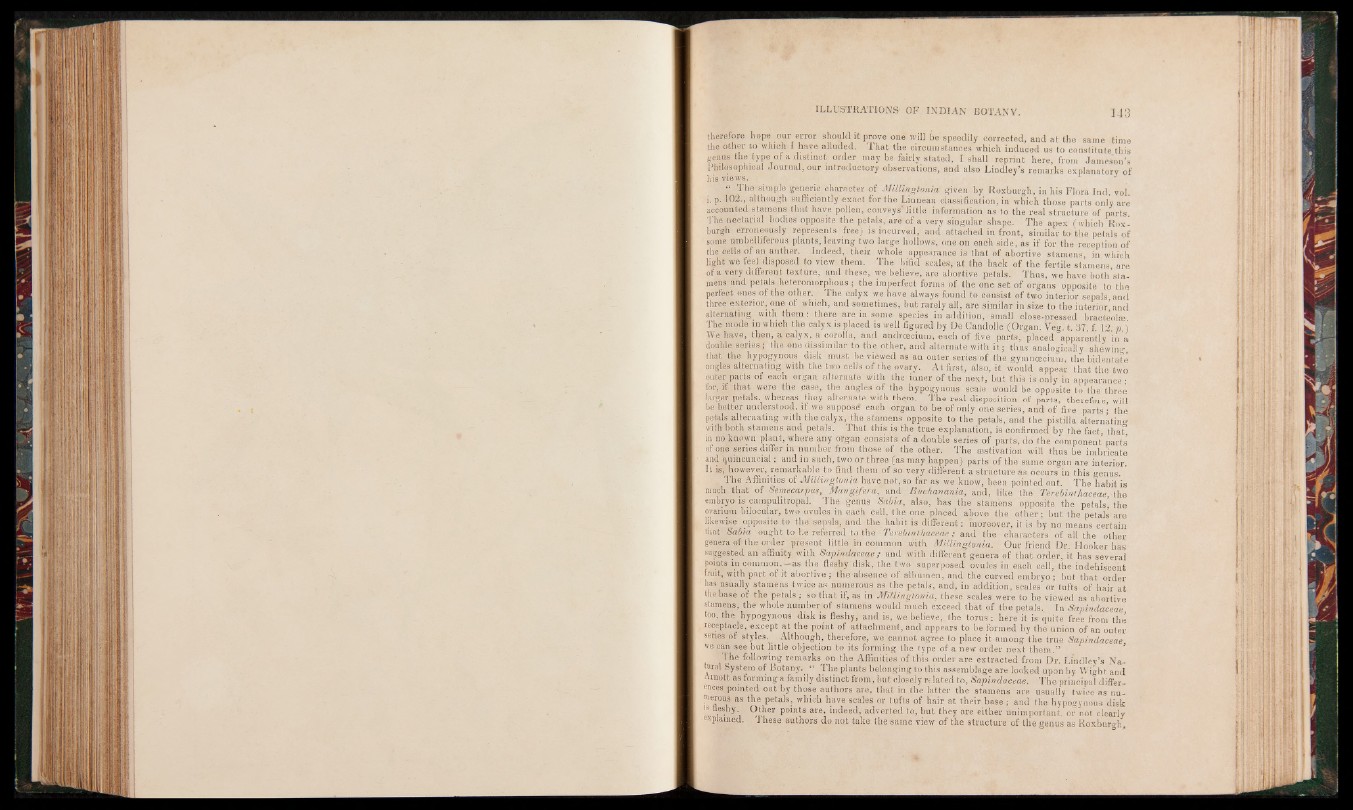
therefore hope our error should it prove one will be speedily corrected, and at the same time
the other to which I have alluded. That the circumstances which induced us to constitute this
genus the type of a distinct order may be fairly stated, I shall reprint here, from Jameson’s
Philosophical Journal, our introductory observations, and also Lindley’s remarks explanatory of
his views. .
“ The simple generic character of Millingtonia given by Roxburgh, in his Flora Ind, vol.
i. p. 102., although sufficiently exact for the Linnean classification, in which those parts only are
accounted stamens that have pollen,, conveys' little information as to the real structure of parts.
The nectariaT bodies opposite the petals, are of a very singular shape. The apex (which Roxburgh
erroneously represents free) is incurved, and attached in front, similar to the petals of
some umbelliferous plants, leaving two large hollows, one on each side, as if for the reception of
the cells of an auther. Indeed, their whole appearance is that of abortive stamens, in which
light we feel disposed to view them. The bifid scales, at the back of the fertile stamens, are
of a very different texture, and these, we believe, are abortive petals. Thus, we have both’sta-
mens and petals heteromorphous ; the imperfect forms of the one set of organs opposite to the
perfect ones of the other. The calyx we have always found to consist of two interior sepals and
three exterior, one of which, and sometimes, but rarely all, are similar in size to the interior’ and
alternating with them: there are in.some species in addition, small close-pressed bractéolæ
The mode in which the calyx is placed is well figured by De Candolle (Organ. Veg. t. 37 f 12 » )
We have, then, a calyx,a corolla, and andrcecium, each of five parts, placed “apparently in a
double series,; the one dissimilar to the other, and alternate with it; thus analogically shewing,
that the hypogynous disk must he viewed as an outer series/of the gyinncecium, the bidentaté
angles alternating with tile two cells of the ovary. At first, also, it would appear that the two
outer parts of each organ alternate with the inner of the next, but this is only in appearance;
for, if that were the case, the angles of the hypogynous scale would be opposite to the three
larger petals, whereas they alternate with them. The real disposition of parts, therefore, will
be better understood, if we suppose each organ to be of only one series, and of five parts ; the
petals alternating with the calyx, the, stamens opposite to the petals, and the pistilla alternating
with-both stamens and petals. That this is the true explanation, is confirmed by the fact, that
in no known plant, where any organ consists of a double series of parts, do the component parts
of one series differ in number from those of the other. 'The estivation will thus be imbricate
and quincuncial ; and in such, two or three (as may happen) parts of the same organ are interior.
It is, however, remarkable to find them of so very different a structure as occurs in this genus. ’
1 he Affinities of Millingtonia have not, so far as we know, been pointed out. The habit is
much that of Semecarpm, Man g if era’ Buchanania, and, like the Terebinthaceae -the
embryo is campulitropal. The genus Sabia, also, has the stamens opposite the petals’ the
ovarium bilocular, two ovules in each cell, the one placed above’ the other; hut the petals are
likewise opposite to the sepals, and the habit is different: moreover, it is by no means certain
that- Sabia ought to be referred to the Terebinthaceae; and the characters of all the other
genera of the order present little in common with Millingtonia. Our friend Dr. Hooker has
suggested an affinity with Sapi.ndaceae; and with different genera of that order, it has several
points in common,—as the fleshy disk, the two superposed ovules in each cell, the indéhiscent
buit, with part of it abortive; t-heabsence of albumen, and the curved embryo; but that order
has-usually stamens twice as numerous as the petals, and, in addition, scales or tufts of hair at
the basé of the “petals ; so that if, as in Millingtonia, these scales were to be viewed as abortive
stamens, the whole number of stamens would much exceed that of the petals. In Sapindaeeae
too, the hypogynous disk is fleshy, and is, we believe, the torus : here it is quite free from thé
receptacle, except at the point of attachment, and appears to be formed by the union of an outer
series of styles. Although, therefore, we cannot agree to place it among the true Sapindaeeae
we cçn see but little objection to its forming the type of a new order next them.”
The following remarks on the Affinities of this order are extracted from Dr. Lindley’s Natural
System of Botany. • The plants belonging to this assemblage are looked upon by Wight and
Arnott as forming a family distinct from, but closely related to, Sapindaeeae. The principal differ-
finces pointed out by those authors are, that in the latter the stamens are usually twice as numerous
as the petals, which have scales or tufts of hair at their base ; and the hypogynous disk
is fleshy Other points are, indeed, adverted to, but they are either unimportant, or not clearly
explained. These authors do not take thé same view of the structure of the genus as Roxburgh